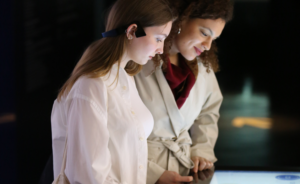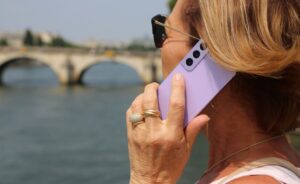Blog

Audiovisual Synchronization in Museums: An Improved Multilingual Experience
In the context of globalization and international tourism, multilingual audio guides have become essential tools for museums, exhibitions, and other cultural institutions. They allow visitors from all over the world to enjoy content in their native language, making the cultural experience more accessible and enriching. However, integrating and synchronizing this multilingual content with audiovisual elements or animated shows poses significant technical challenges. This article explores current technologies that facilitate this synchronization and examines emerging trends in this area.
The Challenges of Multilingual Synchronization in Audio Guides
Synchronization of multilingual content in audio guides is crucial to providing a seamless and immersive visit experience. One of the main challenges is the need to ensure that each user receives information that is perfectly aligned with the current visual or animated elements. In immersive exhibitions or animated shows, where the visitor experience is strongly influenced by the timing of events, temporal precision becomes a critical element.
Furthermore, audio guides must adapt to the different comprehension rates of visitors, which can vary depending on the language spoken or age. Another difficulty lies in managing technical interference. In an environment saturated with electronic devices, signals can be disrupted, making it difficult to maintain precise timing.

Current Synchronization Technologies in Audioguides
To overcome these challenges, various technologies have been developed, each with their own advantages and limitations.
One of the most commonly used technologies is radio frequency identification (RFID) and Bluetooth beacons. These systems allow specific audio segments to be automatically triggered when the user approaches a certain point in a given space. For example, in a museum, when a visitor approaches a particular installation, an explanation in their chosen language can be activated automatically. However, the accuracy of these systems strongly depends on the density of the beacons and the layout of the space.
These systems can be programmed to adjust content based on the speed at which a user progresses through a space.
Timing systems using Wi-Fi are also common in museums and galleries. They allow audio content to be synchronized with videos or projections in real time. These systems can also dynamically adjust content based on the user’s position, providing a more immersive experience. However, the reliability of these systems may be affected by the quality of the Wi-Fi signal, which may vary depending on the environment.
Infrared technology offers another solution for precise content synchronization. Used primarily in environments where Wi-Fi or Bluetooth might be unreliable, it relies on infrared sensors that detect the presence of a visitor and trigger corresponding audio content. This method is often favored in theaters or for animated shows where strict control of timing is crucial. However, infrared requires a clear line of sight to function properly, which may limit its use in certain contexts.
Emerging Trends in Multilingual Synchronization
The field of multilingual synchronization is constantly evolving, with the emergence of new technologies that promise to further improve the visitor experience. One of the most promising trends is the integration of artificial intelligence (AI) and machine learning into audio guide systems. These technologies enable real-time analysis of visitor behavior and can automatically adjust content based on their interactions. For example, AI could anticipate a visitor’s needs based on their previous reactions and adjust the timing of content to provide a more personalized and smoother experience.
Augmented reality (AR) and virtual reality (VR) also open up new perspectives for content synchronization. In an AR or VR environment, multilingual content can be synchronized not only with visual or animated elements in real time, but also based on the visitor’s interaction with the virtual environment. This technology allows for total immersion, where audio and visual content are seamlessly integrated to create a truly immersive experience.
Gesture control systems, although still in the experimental phase, also offer interesting potential for synchronizing audiovisual content. These systems allow visitors to control the information they receive based on their gestures, which could make the experience more interactive and personalized. For example, a visitor could simply point to a work of art to automatically trigger a description or comment in real time, synchronized with what they are currently viewing.

The Future of Multilingual Synchronization: Towards a Richer and Inclusive Experience
The evolution of synchronization technologies in multilingual audio guides marks a significant step forward towards a richer, more immersive and more inclusive visiting experience. While Bluetooth, Wi-Fi and infrared-based systems already offer effective solutions, emerging trends like AI, augmented reality and gesture-controlled systems promise to further transform the museum experience.
These innovations are not only technical advances, but they also represent a commitment to increased cultural accessibility. By offering precisely synchronized multilingual content, museums and other cultural institutions can attract a wider international audience and provide everyone with a personalized and enriching experience.
However, these technological advances do not come without challenges. Integrating technologies like AI and AR requires significant investment, as well as technical expertise for their implementation and maintenance. Additionally, personal data management and user privacy are becoming growing concerns, especially with the use of AI and machine learning.
Despite these challenges, the potential for these technologies to transform the museum experience is immense. As museums and other cultural institutions continue to adopt and integrate these innovations, they will be able to provide visitor experiences that are not only informative, but truly captivating and accessible to all.
Technological Evolution Serving an Immersive and Inclusive Cultural Experience
Synchronizing multilingual content in audio guides is an evolving field, with increasingly sophisticated technologies overcoming technical challenges and providing an enhanced visitor experience. Whether through infrared technology, Bluetooth, Wi-Fi, or emerging trends like artificial intelligence and augmented reality, museums and other cultural institutions have at their disposal a powerful set of tools to offer their visitors an immersive, personalized and inclusive experience. By continuing to explore and adopt these technologies, they will not only enrich the cultural experience of visitors, but also contribute to a better understanding and appreciation of our global cultural heritage. Audiovisual synchronization in museums: an enhanced multilingual experience





